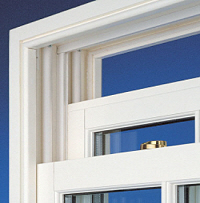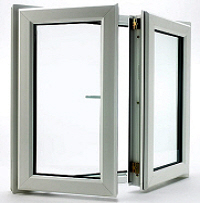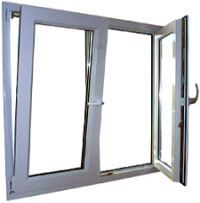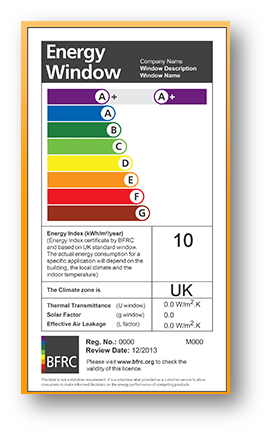Double Glazed Windows
Double Glazed Windows for your home
In general terms it would be fair to say that double glazed window styles come in four easily recognisable appearances, each one having its own unique selling point or characteristic.
In terms of choosing a particular style of window there are really 2 options, match the existing style or go for a totally different look, which can be illustrated where older properties with Sash Windows have had them replaced with Casement Windows. Other times you may be constrained to match the look and styling due to planning restrictions or have soemethng like a Bow or Bay window which can only be replace with the same design.
- Check out our basic double glazing prices guide
Replacement Windows Designs & Style Options
Casement Windows
 Typically seen as outward opening, hinged at the side (casement) or at the top (awning). Very rarely they may be hinged at the bottom of the frame (hoppers) and open inwards. Casement Windows are probably the most popular type of window in the UK seen in many homes.
Typically seen as outward opening, hinged at the side (casement) or at the top (awning). Very rarely they may be hinged at the bottom of the frame (hoppers) and open inwards. Casement Windows are probably the most popular type of window in the UK seen in many homes.
Modern uPVC casement windows have energy efficiency to A++ rated by BFRC. They can also feature internal beading on glazed sections & multi-point locks for security.
Sash Windows
 This style is characterised by its way of opening vertically by sliding the windows up or down, with the top & bottom opening sections each taking up half of the window area. The weight of the moving windows is counter- balanced either by weights hidden inside the frame & linked via a pulley or by pre-tensioned springs.Special hinges can be fitted to modern upvc sash windows that detach, which enable the window to tilt or turn for easy access.
This style is characterised by its way of opening vertically by sliding the windows up or down, with the top & bottom opening sections each taking up half of the window area. The weight of the moving windows is counter- balanced either by weights hidden inside the frame & linked via a pulley or by pre-tensioned springs.Special hinges can be fitted to modern upvc sash windows that detach, which enable the window to tilt or turn for easy access.
French Windows
 A pair of side hinged casement windows hung in a single frame similar to a double door where the handles are at the centre and the hinges are at the sides. Both inward and outward opening version can be found.
A pair of side hinged casement windows hung in a single frame similar to a double door where the handles are at the centre and the hinges are at the sides. Both inward and outward opening version can be found.
Most often thought of as the type of window that you see on a ‘Juliet balcony’ and larger versions would be used as French doors.
The classic look is to have many smaller panes of glass to make up the whole window opener itself, in uPVC French windows, this can be achieved by using Georgian bars inside the the glazed units.
Tilt & Turn Windows
 A relatively modern invention, unlike the preceding styles which have been around for hundreds of years, tilt & turn windows do exactly as their name suggests.
A relatively modern invention, unlike the preceding styles which have been around for hundreds of years, tilt & turn windows do exactly as their name suggests.
The window opener can be used in the same fashion as a regular casement window (other than tilt & turn open inwards) however, they have an extra opening method allowing the window to be tilted back into the room.
The window tilts backwards from the top and the overall angle of tilt is restricted by a safety limiter. Larger tilt & turn windows can be quite easily used as doors.
What does ‘WER’ mean & why is it important for double glazed windows?
 You will find references throughout the website to what is known as the ‘WER’ for double glazed windows & doors; this is an abbreviation for Window Energy Rating and is a colour coded ranking for the energy efficiency of the complete fitted unit (not just the glass).
You will find references throughout the website to what is known as the ‘WER’ for double glazed windows & doors; this is an abbreviation for Window Energy Rating and is a colour coded ranking for the energy efficiency of the complete fitted unit (not just the glass).
The rating is provided by the British Fenestration Rating Council and is important because of the UK building regulations which apply to new windows & doors whereby, since 2002 all installation have to comply with legislation about product performance – if your windows & doors are not certified, then you may have some problems when it comes to selling your property, quite similar in that you need an EPC (Energy Performance Certificate) for the whole property to buy, sell, build or rent a home in the UK (more info here: www,gov.uk).
In principle, the rating system runs from A-G & from red to green (like a traffic light), with A & green being most efficient – although you can find double glazed windows with A+ ratings (blue & purple) in the market place.
Colours & Glass options
All of the window types can be found in coloured versions. UPVC units have around 10 to 12 different colours.
Glazing can be clear, obscure or patterned. For where a “window of character” is required, you can also get leaded double glazed sealed units, but they will cost a little more.
Which material is best to use for double glazed windows?
Your basic choices are UPVC, Timber or Aluminium. Each of these materials has their own plus or minus points, so here is a quick comparison.
Timber Windows
What is good about wood?
- It looks natural, because it’s the real thing.
- Can be painted or stained to almost any shade or colour.
- You have soft wood or hardwood options
- Softwood windows can be quite cheap to buy.
- Wood itself is a decent insulating material to build a window or door from
What is not so good about wood?
- It takes a lot of looking after.
- If you don’t look after a timber window it can “fail” comparatively quickly.
- Timber swells when it’s wet & shrinks when it’s dry. Causing paint cracking or peeling and possibly causing gaps around the frame where water can penetrate.
- If the timber is not treated for it, then rot can set in and ruin the window
- You have to paint or stain it, and then keep the paint or stain in good condition.
Aluminium Windows
What is good about using aluminium?
- It lasts a very long time.
- You can get aluminium windows in almost any colour.
- Modern versions are energy efficient
- Aluminium is a very lightweight material.
- Slimline contemporary look.
What is not so good about aluminium?
- Poorly manufactured examples can corrode & discolour quickly.
- Some folks think it looks “cold” with no character.
- Less popular in family homes, so it can be a bit costlier to buy
- Aluminium is an excellent conductor of heat & cold. You need to make sure that the ones you buy are highly energy efficient models with proper thermal breaks built in
UPVC Windows
What’s so good about uPVC?
- Can be inexpensive to use
- Very lightweight material
- Can be made into different colours
- Low maintenance
- Long lasting
What is not so good about uPVC?
- Poorly manufactured examples can warp or discolour quickly.
- Some designs can have thick chunky frames
- Welded frames (if not reinforced) can distort and fit badly over time
Summary
From a cost effective and design choice point of view, you could argue that timber & uPVC offer the best solution.
Taking into account the levels of maintenance required then you could argue that Aluminium & uPVC have a strong case.
However, the one material that seems to consistently “score well” against the others is uPVC.
So in our opinion, unless there is a specific reason in your case to use timber or aluminium, uPVC Windows offer the best combination of design choice, colour selection, durability, cost effectiveness and market availability.
